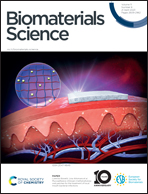Biomedically-relevant metal organic framework-hydrogel composites
Abstract
Metal organic frameworks (MOFs) are incredibly versatile three-dimensional porous materials with a wide range of applications that arise from their well-defined coordination structures, high surface areas and porosities, as well as ease of structural tunability due to diverse compositions achievable. In recent years, following advances in synthetic strategies, development of water-stable MOFs and surface functionalisation techniques, these porous materials have found increasing biomedical applications. In particular, the combination of MOFs with polymeric hydrogels creates a class of new composite materials that marries the high water content, tissue mimicry and biocompatibility of hydrogels with the inherent structural tunability of MOFs in various biomedical contexts. Additionally, the MOF–hydrogel composites can transcend each individual component such as by providing added stimuli-responsiveness, enhancing mechanical properties and improving the release profile of loaded drugs. In this review, we discuss the recent key advances in the design and applications of MOF–hydrogel composite materials. Following a summary of their synthetic methodologies and characterisation, we discuss the state-of-the-art in MOF–hydrogels for biomedical use - cases including drug delivery, sensing, wound treatment and biocatalysis. Through these examples, we aim to demonstrate the immense potential of MOF–hydrogel composites for biomedical applications, whilst inspiring further innovations in this exciting field.

- This article is part of the themed collection: Biomaterials Science 10th Anniversary Collection


 Please wait while we load your content...
Please wait while we load your content...